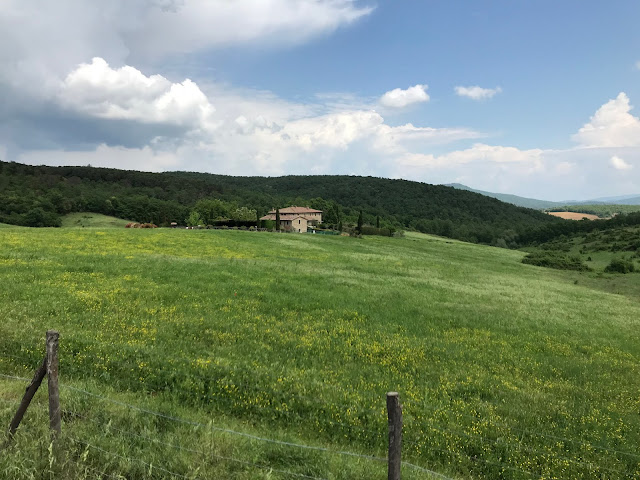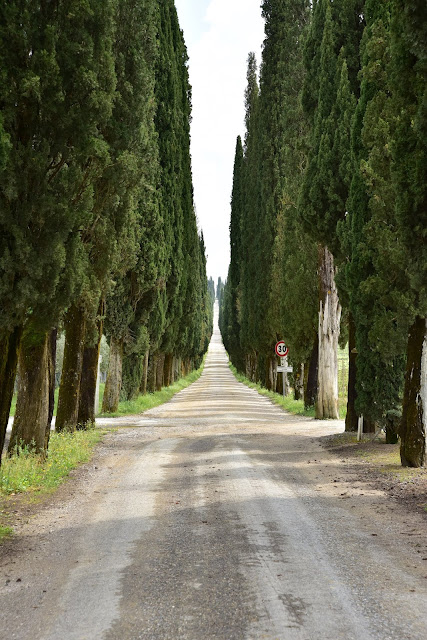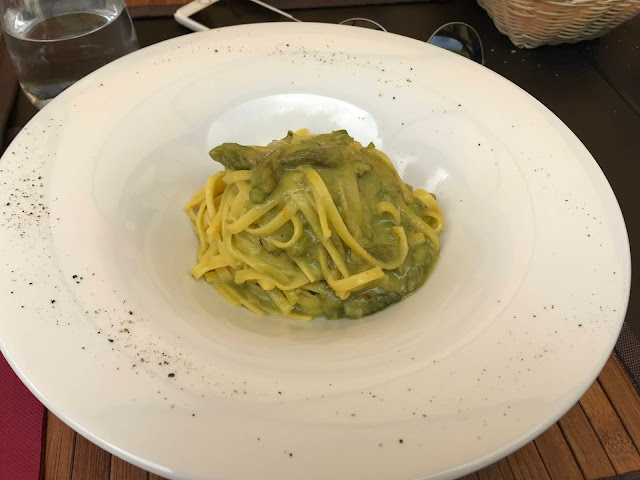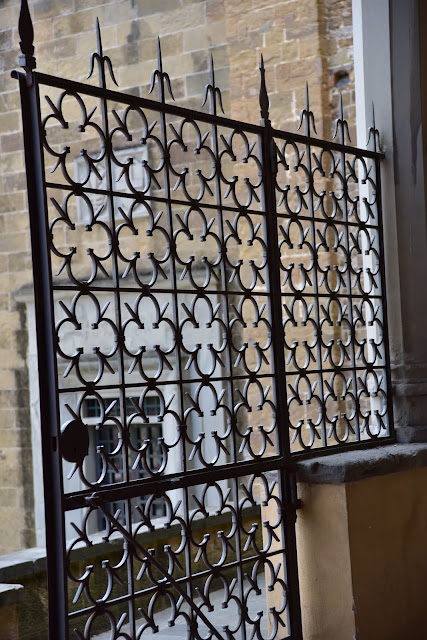It took us hours to rent our van and make our way to the villa Cory and Kristen reserved for the group. The location was a breath of fresh air after the crowds and congestion of Rome, but also difficult to find with Google Maps. We pulled into a villa and watched as Cory went to the gate, leaned over and spoke into the microphone, "This is Cory Edwards." A gracious woman greeted us (well, not me, because I was trying hard not to puke by the side of the car from the winding roads). Cory expectantly repeated himself, "Hi, I'm Cory Edwards." She replied, arms welcoming and open, "Tell me! Yes, I know that! Tell me why you are here?" That was our clue that this was not the right place, but she showed us around her estate and even offered to cook us dinner. We declined and went back to the twists and turns of the road until we found the right location.
It was late by the time we were checked in and we went to find dinner in the tiny town. We found a restaurant, sat down, and ordered in English. I felt awkward when we asked lots of questions to our waiter, as his English was clearly not as good as servers we had in Rome. Obviously not his issue--he speaks his own language perfectly, I'm sure, and we are visiting his country. Unfortunately, something was lost in translation and gluten-free Cory ended up with no entree. Angela was so upset and transitioned to mama-bear mode. It was funny and endearing to see her get so defensive over her brother.
We came back to the villa where Cory established ambiance with dozens of candles lit, and we talked on the covered porch with the flickering flames.
The next morning, we woke up to spectacularly clear skies and the photographers caught their memories while I worked out on the roof.
When Kristen told us pre-vacation that they hired a chef and I found out she was female, I was excited (yay, accomplished women!). Then, I realized that we actually should be rooting for a pool boy. Looking for our Italian pool boy was a running Tuscany joke.
Red poppies were abundant in Tuscany.
The roads in the Tuscany/Florence area are narrow with an abundance of street signs. Each day, we drove up a tiny street that was clearly marked DO NOT ENTER in Italian symbols, yet it was the obvious way to go. Every time, Kristen and I held our breathe and panicked a little. Angela struggled sitting in the seat behind Brady, the only driver for the vehicle, because every time a car passed, she was sure it would kill us all. Paul worked to reassure Brady and the group that he had confidence in his driving prowess: "Brady's been known to circumcise a gnat with a buck knife. Anyone with that much skill and precision--I have no question--can handle this corner," and "He will make the turns if it is humanely possible."
We took off for a day touring Florence, first stopping by a gluten-free bakery to pick up croissants in celebration of Cory's birthday. We love him, but not enough to skip on glutenous croissants, and we ordered some from a cranky woman we offended by sitting down with take-out food.
Our first major stop was the Duomo Climb. Kristen was thrilled to have the lead and darted up the stairs with us on her heels. We anticipated seeing more of the architecture and design of the dome from the climb, but we wound through a narrow staircase surrounded by concrete. Looking closely at this picture, it is clear that our views were limited below. When we looked down, we barely saw any of the dome compared to its size.
For the past year, I started the lengthy process toward getting highly qualified for history teaching (the requirements changed shortly after I graduated). I took a History of the Renaissance course through BYU and finished a month before our trip. Florence was the focus of my class and seeing first-hand the art and architecture I studied was ideal.
The dome encloses Florence's Gothic cathedral with Brunelleschi's ingenious and novel design, which is anything but Gothic. He modeled it after the Pantheon and his accomplishment cannot be overstated. Nothing like this had been done since ancient times and his methods were untested. The enormous cathedral had stood without a dome for many years and was an embarrassment and eyesore to the pride of Florence. Coming off a loss to Ghiberti over the bronze doors (FINISH), Brunelleschi turned his attention to architecture. He created a hoist system that moved heavy materials up and down, he sent food up to workers so they did not lose time climbing, he created an octagonal double shell with herringbone design to support the structure, and he successfully completed the largest dome in the world at that time. It was his crowning achievement and architects and engineers are still in awe over the work and brilliance of a then-amateur.
Brunelleschi's Ospendale degli Innocenti was a highlight for me. With the push for humanism, the Renaissance began waves of charitable giving, and this hospital focused on care of unwanted children and orphans. The building itself is a key example of Renaissance architecture with balanced columns that make up an arcade. It's decorated between columns with terr-cotta medallions that each show a baby wrapped in a way that will help them grow straight. Baby wrapping only stopped a hundred years ago.
Orphans and abandoned babies were left at the "wheel of innocents":
Florence was notably more clean that Rome.
Our next destination was a 15th century monastary full of paintings by Fra Angelico. Renaissance paradigm-shaper Vasari called him "a rare and perfect talent." His work is clearly early Renaissance as forms are not fully 3D and realistic, but they are changing in form from Medieval work. The Museum of San Marco also held art from the cells of Savonarola, the infamous monk who resided here and carried enough power in Florence to oust the Medici for a time, convinced the people to burn books, paintings and jewels, but later met a gruesome death by hanging and burning on the stake.
Lunch at Ciro and Sons ("Best Gluten Free Pizza in the World!") helped me understand that our previous trips to Europe lacked a major cultural component--spending quality time dining. A family-owned restaurant with wedding pictures, family pictures, and modern decor and bathrooms, every minute there felt personal and welcoming. It helped that the pizza was delicious--cheese....yummmmmm. Our server, Josepi, knew English well and we learned that he had an American wife and four children. He told us that the kids come with them everywhere, including to parties until 2am. Ha! Later in the meal, we looked over and recognized the adults of the family all sitting together for lunch, recognizing them from their pictures on the wall.

My favorite stop of the day was the Bargello Museum, full of Renaissance treasures.
The Pitti Tondo (or "Madonna and Child with Young Saint John") by Michelangelo: Michelangelo just finished David and completed this small round "tondo" for the wealthy Pitti family. I love the young Jesus seeking his mother's attention and curling his body around Mary.
Bust of Brutus, by Michelangelo: The conflict in his face reflected in the work took my breath away. The view from the front looks courageous and determined, but approaching it around the corner, the other half of his face looks cynical, like a man who could turn on Caesar, his mentor. Rick explained that Michelangelo felt much like Brutus at the time of this creation--conflicted over the politics of his country. Michelangelo was raised by the Medici family but disapproved of the power and force they were in Florence and loss of republican rule. This work added to my conviction that seeing art in person is infinitely better than in books.
David, by Donatello: the flamboyant, arrogant ease of this David! The details from the feathers stretching sensually up his inner thigh to his soft, youthful physique and contrapposto pose almost made me giggle. This was the first nude male sculpture Europe had seen in 1,000 years, and to start off with this work certainly made a statement. The body in Medival times was shameful and hidden, and Renaissance did away with that thinking, bringing in a focus on the individual and celebrating the human body.
The small, bronze art pieces that kicked off the Renaissance: Ghiberti v. Brunelleschi in a 1401 contest to win the commission for the Baptistry doors. Ghiberti won, leading Brunelleschi to switch his focus completely to architecture. Seeing their work side-by-side was fascinating, and for the record, I did like Ghiberti's better. The forms in both are real and lifelike--agonizing stances and intense emotion. I loved Isaac's puffed out chest in Ghiberti's work, almost daring Abraham to strike.
Donatello's St. George, a depiction with humanist qualities such as a composed body and watchful, alert eyes. He is the fabled dragon-slayer warrior but shown instead as a Christian who could defeat any enemy with intellect. He was a prominently displayed in Florence and a symbol of powerful for the city-state.
I loved this work of Mary and Jesus. Blue colors are associated with Mary in most work, as blue was the most expensive color to produce.After a quick visit to the Pharmacy, Paul and Angela joined back up with us to visit the Accademia to see David by Michelangelo.
I hear people describe first seeing the Mona Lisa and feeling disappointment at her size. I did not personally feel that way, but I wondered if my expectations were too high for David. They were not; he is a masterpiece. 14' tall and striking from every angle. Michelangelo was only 26 and coming straight from his Pieta when he created this from one large, somewhat cast off piece of marble. I liked Rick's explanation that he likely is about to slay the giant (no Goliath head is pictured). His right hand is proportionally larger representing the hand of God. He is composed and confident.
He looks less confident from this angle--his eyes sizing up the giant. His left arm was broken off in 1527 when a table fell down onto the sculpture during a riot. It was restored and become the ultimate symbol of the Renaissance--optimism and belief in mankind.
Giambologna, The Kidnapping of the Sabine Women, 16th century, illustrating the Roman mythology of Roman men taking women from other cities. The husband is below the twisting trio, resisting fruitlessly. Giambologna carved this from one block of marble.
We spent time walking the city and across the Ponte Vecchio bridge, then walked to catch full views of the city. On the way, we found a vendor creating giant bubbles that we popped like 2-year-olds in the setting sun, overlooking the stunning views.
We loved this wall, and so did Kristen. She wanted to get a close up and did not realize the moss was actually waist-deep water. She saved the camera and fell in almost completely. Lucky for us, she is a good sport and seemed unfazed by the experience, willing to laugh hard. Lucky for her, I had a spare skirt and pair of shoes in my Mary Poppins backpack.
We escaped pounding rain and enjoyed a late dinner celebrating Cory's birthday at the Ristorante Sant' Ambrogio and creating another list of things we love about him. Cory and Ang are easy to love and it was fun exchanging memories over delicious food and capping it off with hot cocoa that was so rich, it nearly solidified in my cup. That night, we were surprised at the villa with no electricity and spent an hour trying (and failing) to find all the breakers.
The next morning came early after a 1:30am bed time, and the weather was socked in and gray. Combined with an unanticipated lengthy drive to our destination and a sick Paul and Angela, our biking Tuscany agenda looked questionable. We went for it anyway and it was hands-down the best day of our trip.
Our kick off point was a sleepy area called Castelnuovo Berardenga. For a mere 35 euros, we rented a bike with power assistance, which was a jolly little button that propelled you uphill or on level ground. It was a perfect tool to help with those not feeling up to major physical exertion (I'm looking at you, Angela--who turned out to have pneumonia!), and freed up extra distance we could not otherwise achieve. The owner of the shop equipped us with our gear, but spoke no English. Google Translator saved us, and at one point, the owner pleasantly and enthusiastically said, "Go! Go! Go!," which cracked Brady up.

Images from San Guzme:

We found what appeared to be the only open restaurant.
The way home was brutal for me with a case of tummy twisters from winding roads, and I graced the side of the road with lunch for everyone in the van to enjoy. Brady thoughtfully put on loud music each time we pulled over. I was shaky and dizzy getting back to the villa, but recovered quickly in time for one of the splurges of the trip: hiring a chef to cook for us. Marta made the tastiest, most fresh bruschetta I have ever tasted, and the next course's hot risotto with cold asparagus was one of Brady's favorite food memories of the trip. The melted gelato dessert that looked like a murder scene was another memorable experience, and we were glad she understood no English.
Our candy striper room in the villa:

After plenty of discussion, we settled on an itinerary for Thursday morning, stopping into Florence for the Uffizi gallery. The Uffizi held masterpieces of the Renaissance and I was most excited about seeing the evolution of art from the 14-16th centuries and comparing it to my studies.
Giotto's Madonna and Child from 1310. Giotto kicked off elements of Renaissance art but the 1348 plague knocked art back for another hundred years. He uses realism and multiple dimensions in his work. Mary's legs and breasts appear real and lifelike. Jesus, however, looks like an adult man in a tiny body.
Fra Filippo Lippi's Madonna and Child with Two Angels from 1645. Mary's face is realistic and glowing with beauty, and the angel on the bottom right is darling.
Battista Sforza
Sandro Botticelli's Allegory of Spring, from 1478. I love the Three Graces with realistic features dancing. This painting shows the Renaissance embracing physical bodies rather than hiding them. As the panel explains, it is a celebration of love and prosperity.
Botticelli's The Birth of Venus, 1485. Hooray for female representation and beauty! Her body is in an S-curve and intended to be innocent rather than sensual as she is born from the foam of a wave, and Botticelli believed that celebrating beauty and humanity was a way of celebrating God. I loved her pensive eyes.
Paul's comment: "We've seen a lot of nude men. We were due for a woman."
Paul's comment: "We've seen a lot of nude men. We were due for a woman."

After all the pictures of David, we needed a selfie with Venus.
 I do not recall anything about this but Brady took the picture to laugh about it.
I do not recall anything about this but Brady took the picture to laugh about it.Leonardo da Vinci's The Annunciation from 1475.
 Michelangelo's The Holy Family from 1506. This is his only finished easel painting. It is clear he is a sculptor--the bodies appear as statues with boldly colored clothing. The background is pagan while the foreground obviously Christianity, showing a link between the two worlds.
Michelangelo's The Holy Family from 1506. This is his only finished easel painting. It is clear he is a sculptor--the bodies appear as statues with boldly colored clothing. The background is pagan while the foreground obviously Christianity, showing a link between the two worlds.Bugiardini's Madonna and Child, 1518. I loved this one: #normalize breastfeeding.
Raphael's Madonna of the Goldfinch. The children play with a bird, adding to the human warmth and feeling of the work, and the painting can be split precisely down the middle of Mary's nose. Raphael painting during the High Renaissance, and this work is the culmination of the balance and realism of the Renaissance.
Another less famous but exquisite work: Albertinelli's Visitation, Annunciation, Adoration of the Christ Child and Circumcision, 1503.
We named this one Baby Bird's Last Breath.
Parmigiano, Madonna of the Long Neck, 1535. This was one of the most obvious mannerist paintings I studied for my class. A long Jesus flops around on her legs, appearing like he might fall at any moment. Her neck is exaggerated, a column in the background leads to nowhere, she is sitting awkwardly with her foot projecting almost out toward us, and her body is illogically proportioned compared to the angels and St. Jerome on the right. Mannerism throws the Renaissance harmony out the window with the objective to perplex.
Artemisia Gentileschi, Judith slaying Holofernes, 1620. I loved walking around the corner and finding this gem. Gentileschi was one of the most prominent painters of the time, and this violent illustration of Judith taking revenge reflects on Gentileschi's own experiences with rape.
Leonardo da Vinci's unfinished Adoration of the Magi, 1481-3. This unfinished work was given a special room and display and we watched an interesting video on the restoration of the painting. It is dark and brooding and makes me wish we could see his finished version of this piece.
We visited the Santa Croce church with tombs of famous Florentines, as well as Florence's Lady Liberty by Pio Fedi. There is certainly a connection between the Statue of Liberty and this work, although no proof they are connected.
Father of modern science, this is Galileo's final resting place.
Michelangelo's remains were snuck back to Florence from Rome to stop here. Other prominent tombs include those for Machiavelli and Dante.
Mid-afternoon, we drove to San Gimignano. We practiced pronouncing it repeatedly before settling on calling it San Jimmy John's for the rest of the trip. If I planned this trip independantly, there is no way I would have included hours of walking around aimlessly in a Tuscany hillside town. However, after the bustle of art museums and crowds of big cities, wandering through tacky shops and taking a hundred photos of the reddish brick, towers and hills made the itinerary a total score.
After this trip, I think we are good on couples pictures for another five years.
El Guapo Paul. He is not posed.
Can you believe this is really the first time I've ever participated in a jumping picture? Now that I'm on the flip side of 30s, it should probably be the last.
"Gelato World Champion" helped us continue the gelato streak.
This medieval city is known as "The Town of Fine Towers" because of the original 72 that stood, there are still 14 remaining. Romeo and Juliet-style, two competing rivalries in the town built up ego towers until an ordinance prohibited any more. The plague killed off 50% of the inhabitants and it was swallowed by Florence, with many towers taken down to roof height.
Breathtaking by day, charming at night. We scored an outdoor table with the most scenic view I've ever experienced for dinner, and complimented by four tables of heavy smokers.
Friday morning, we checked out of the villa and headed back to return the damaged rental car. It was clearly scraped up before we were given the keys, because the damage was substantial and we only noticed it after getting out of the car the first time. The way in was blocked to us when we rented the vehicle, and we stupidly neglected to do an inspection. Paul and Brady spent a solid hour arguing with the employee about the case, and we were relieved to get off the hook because of Budget's documentation of a car with that number having damage at that spot (although the car itself was not described correctly in the documentation). Lucky, lucky, lucky.
The highlight of the day was standing together and analyzing Ghiberti's "The Gates of Paradise" in the Duomo Museum. Created for the Baptistry but preserved in the museum, the realism and 3D effects are revolutionary and fascinating in person. They include depictions of Noah, Jacob and Esau, Moses, Joshua and David. I tried to point something out on one of them and hit my finger so hard on the glass that it turned black and blue.
I loved noticing the difference between the Abraham/Isaac panel and his original panel for the competition against Brunelleschi.
Donatello's Mary Magdalene carved in wood haunted me. A gaunt and haggard Mary, she is penitent and seeking forgiveness.
Michelangelo designed his own tomb with this Pieta as the centerpiece. Nicodemus is actually his own face, helping us see his personal religious devotion.
Last stop, the Pitti Palace, with art masterpieces from the High Renaissance by Titian and Raphael.
Another Artemesia Gentileschi, another #normalizebreastfeeding.
The Boboli Gardens, where we cruised for about 30 minutes in the blazing sun but found a pocket of roses and view of the city.
We left Florence by train feeling satisfied with the city and the art.
































































































































































